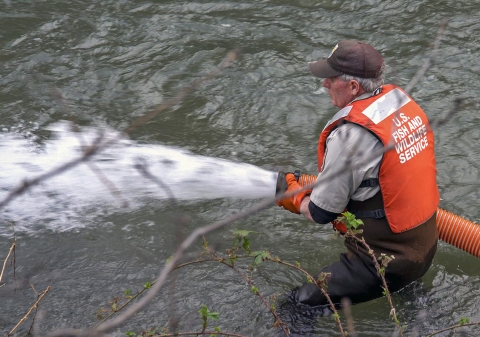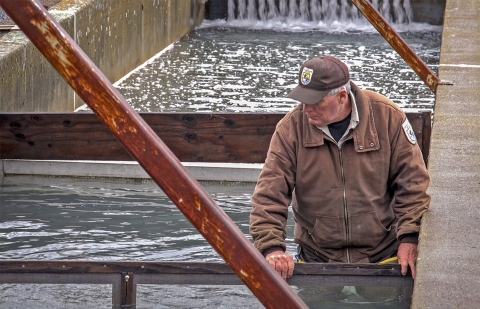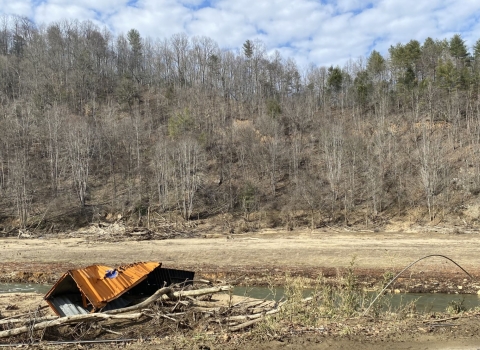Winter-run Chinook salmon are unique in that they spawn during the summer months, from mid-April to mid-August, when California is at its hottest. This proved to be catastrophic in 2014 and 2015 when the drought killed nearly the entire in-river juvenile salmon population.
This event prompted the U.S. Fish and Wildlife Service, the National Marine Fisheries Service and the California Department of Fish and Wildlife to reinitiate the captive broodstock broodstock
The reproductively mature adults in a population that breed (or spawn) and produce more individuals (offspring or progeny).
Learn more about broodstock program at Livingston Stone National Fish Hatchery, part of the Coleman National Fish Hatchery Complex. The program started in 1992 and was suspended in the early 2000s.
Last year, the Service released 220,000 tagged and fin clipped juvenile winter-run Chinook salmon into the north-fork of Battle Creek. This year, in a continuing effort to jump start the population, 185,000 juvenile winter-run Chinook salmon were released.
“We are trying to expand their population,” said Brett Galyean, Coleman’s project leader. “Currently winter-run salmon are in the upper Sacramento River, and there is a large effort to restore Battle Creek and improve the habitat. By doing this jump start effort, we are just moving ahead with the reintroduction plan to repopulate winter Chinook salmon into upper Battle Creek.”
The jump start plan uses the offspring of captive broodstock winter-run Chinook salmon from Livingston Stone and is focused on reintroducing winter-run to Battle Creek while not impacting the Sacramento River population.
“This year is about fine-tuning, we learned a lot from the first year,” said Galyean. “Winter Chinook act differently than some of the other salmon we have here.
"They seem a little more skittish, so we used belt feeders (feeds throughout the day instead of having someone walk by the raceway or tank and feed the fish every hour) a little bit longer," he said. "Also, we reared them inside longer than we did last year.”
Today, Sacramento River winter-run Chinook salmon are listed as an endangered species under both federal and state law.
National Oceanic and Atmospheric Administration Fisheries also considers winter-run Chinook salmon among eight marine species most at risk of extinction and part of the “Species in the Spotlight” initiative.
“The winter Chinook salmon supplementation and captive broodstock programs at Livingston Stone are absolutely the reason why there are still winter-run Chinook salmon swimming in the Sacramento River,” said Galyean. “The warm water and low river flow conditions during the last drought were devastating on the natural populations of winter Chinook salmon, and both of the programs at the hatchery played a key role in rearing winter Chinook salmon during those years.”
In addition to facing warmer water temperatures, the salmon also have to contend with human-made obstacles.
“Battle Creek has several hydroelectric dams, diversions and a complex canal system that was developed in the early 1900s,” said Laura Mahoney, information and education specialist at Coleman. “The canal system moves water between the north fork and south fork of Battle Creek. However, as part of a restoration project on Battle Creek, modifications will be made to two powerhouses that will prevent water from being mixed between the two forks.”
More than 500 of the salmon received acoustic tags to help track where they travel and their survivability rate. The survival rate helps researchers estimate the number of fish in the ocean and expected to return for spawning.
“Acoustic tags are a form of telemetry that is used in the fisheries field to study the survival, timing and distribution of fish as they move through the system or through watersheds,” said Laurie Earley, Red Bluff Fish and Wildlife program manager for the Battle Creek restoration program. “We are interested in the Sacramento River and the Sacramento-San Joaquin River Delta, especially these salmonids as they travel through the system and make their way out to the ocean.”
It takes about three years for the salmon to make the long journey from the hatchery to the ocean and back. While a few salmon from the 2018 spring release may return to Coleman this year, the majority will return next year.
“We are anxiously waiting their return,” said Galyean. “We are checking the Coleman ponds each day right now hoping to encounter a two-year-old salmon, but the main group will return next year, sometime between February and June.”









